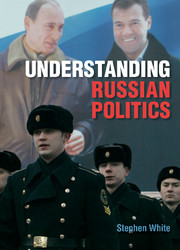Book contents
- Frontmatter
- Contents
- List of figures
- List of tables
- Preface
- Map: administrative units under the 1993 Constitution
- 1 From communist to postcommunist rule
- 2 Voters, parties and parliament
- 3 Presidential government
- 4 From plan to market
- 5 A divided society
- 6 Changing times, changing values
- 7 Russia and the wider world
- 8 What kind of system?
- Notes
- A Note on surveys
- Index
- References
1 - From communist to postcommunist rule
Published online by Cambridge University Press: 05 June 2012
- Frontmatter
- Contents
- List of figures
- List of tables
- Preface
- Map: administrative units under the 1993 Constitution
- 1 From communist to postcommunist rule
- 2 Voters, parties and parliament
- 3 Presidential government
- 4 From plan to market
- 5 A divided society
- 6 Changing times, changing values
- 7 Russia and the wider world
- 8 What kind of system?
- Notes
- A Note on surveys
- Index
- References
Summary
The Union of Soviet Socialist Republics was still growing economically in the Brezhnev years, and expanding its international influence. But growth rates were falling, and social problems were deepening. The Gorbachev leadership, from 1985 onwards, set out a rather different agenda: of glasnost' (openness) and perestroika (or restructuring) ‘We can't go on like this’, the new party leader told his wife as he assumed his responsibilities. In the end, for reasons that are still debated, the reform agenda failed to achieve its objectives and the state itself collapsed as its fifteen constituent republics became independent states after the collapse of an attempted coup in August 1991 that had been intended to preserve a viable union. Gorbachev resigned as Soviet president on Christmas Day and the Russian president, Boris Yeltsin, took over the Kremlin as the head of what was now an independent Russian Federation and by far the largest of the post-Soviet republics.
In early 1982 Leonid Brezhnev was apparently at the height of his powers. General Secretary of the ruling Communist Party since October 1964 and, since 1977, Chairman of the Presidium of the Supreme Soviet of the USSR or head of state, he had presided over a steady rise in living standards at home and an expansion of Soviet influence throughout the wider world. Under Brezhnev's leadership national income had doubled between 1960 and 1970 and more than trebled by 1980. Industrial output had more than quadrupled.
- Type
- Chapter
- Information
- Understanding Russian Politics , pp. 1 - 26Publisher: Cambridge University PressPrint publication year: 2011



